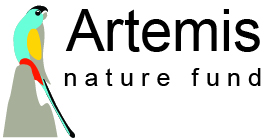Last week we captured two feral cats on Artemis and fitted them with GPS tracking collars. Each feral cat in Australia kills hundreds of native animals each year, are a potentially serious threat to Golden-shouldered Parrots. We need to learn more about them on Artemis, especially in the context of our habitat restoration work. We don’t want to inadvertently make the threat of feral cats even worse.
The collars will turn on for 24 hours every Friday and acquire a GPS fix every 30 minutes. They should do this for about a year. The two cats we caught last week – a male and a female – are the first of several we intend to follow like this over the next year or so. Upon completion, all cats will be humanely removed. The University of Queensland’s Animal Ethics Committee and Biosecurity Queensland have endorsed this work.
A feral cat captured on a camera trap in Artemis’ Antbed Parrot Nature Refuge in December 2019.
There are a few reasons why we need to track feral cats on Artemis.
First, we don’t really know exactly how much of a threat cats pose to adult Golden-shouldered Parrots. By comparing the activity patterns of our feral cats to what we already know about the parrots, we’ll be able to tell how much time cats spend hunting during the day when parrots are most actively feeding on the ground. We’ll be able to tell if this threat changes seasonally and therefore when is the best time to undertake cat control in order to safe-guard parrots.
Second, it’s possible that our habitat restoration work may affect the way cats use the landscape. If we do change the way cats behave, we want to know about it.
And third, it’s never a bad thing to simply learn more about this serious conservation threat. It has been estimated that feral cats kill billions of Australian native animals each year. By increasing our knowledge of cat ranging behaviour in this landscape, our cat control activities should become more effective. This includes sharing information through the Golden-shouldered Parrot Recovery Team so other groups in the region (such as the Olkola Rangers) can improve their cat management programs.
Stay tuned for regular updates about where our tagged cats move over the coming months.
